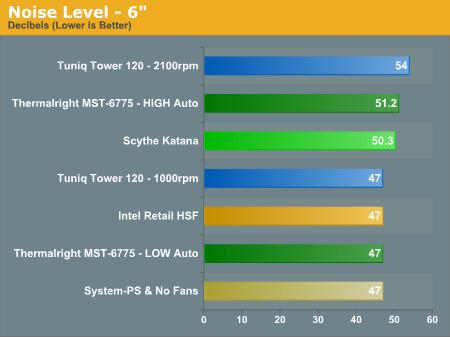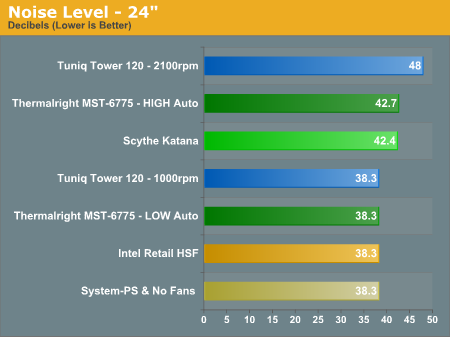Value Cooling: Two Towers for under $30
by Wesley Fink on January 23, 2007 3:50 AM EST- Posted in
- Cases/Cooling/PSUs
Noise
For some users the goal is maximum stable overclock, and they will live with the inconvenience of a louder system. For others silence is the most important factor, and these users will forgo overclocking if this increases system noise levels. Both the Thermalright MST-9775 and the Scythe Katana use 92mm fans running at a relatively slow 2000rpm to reduce noise while still maintaining high air flow for cooling. This is a particularly large fan for cooling solutions aimed at the value end of the cooler market.
In addition, the 4 pin fan connector used by the MST-9775 allows the system to automatically vary fan speed based on CPU temperature. In testing we found the variation between the Auto low and high speeds to be around 1000rpm on low and 2000rpm on high speed. As a result of the variable fan speed results at both low and high fan speeds were measured and reported for the Thermalright.
There are virtually no power supplies that do not have a fan. While Zalman and a few others do make a few expensive fanless power supplies, we are not aware of one that is larger than 500W, or that would be used for seriously overclocking a system. With that in mind the noise level of the system with all fans turned off except the Power Supply was measured. The power supply used for the cooling test bed was the OCZ PowerStream 520, which is one of the quieter high performance power supplies. The noise level of the Power Supply was 38.3db from 24" (61cm) and 47db from 6" (152mm). The measured noise level of the test room is 36.4db, which would be considered a relatively quiet room with a noise floor below the OCZ PowerStream 520 PSU.
Keep in perspective that the dB scale is logarithmic and not linear, so a 3dB increase represents a doubling of sound power. Some studies suggest that while the human ear can discern small differences in sound level, the human ear perceives a doubling of loudness at a 10dB increase. Others quote double the sound level perception as 6db.


Measured noise levels in this chart should be considered worst case. Measurements were taken with an open side of a mid tower case 6" from the HSF and 24" from the HSF. Real world would be a completely closed case with a further reduction in noise.
Subjectively the Scythe and Thermalright were both quiet at the standard fan speed of 2000rpm. However, neither cooler was really as quiet as a stock Intel HSF. The increase in noise will be hardly noticed by most users since the noise increase is small and the noise frequency is not particularly irritating.
When the Thermalright MST-9775 drops to low speed on Auto the measured noise is below the system noise floor. If minimum noise is your goal, a fan speed controller could easily be added to the Katana or the MST-9775 to keep noise levels below the system floor. We found just below top speed - about 1800rpm - dropped measured noise below the system floor.
For some users the goal is maximum stable overclock, and they will live with the inconvenience of a louder system. For others silence is the most important factor, and these users will forgo overclocking if this increases system noise levels. Both the Thermalright MST-9775 and the Scythe Katana use 92mm fans running at a relatively slow 2000rpm to reduce noise while still maintaining high air flow for cooling. This is a particularly large fan for cooling solutions aimed at the value end of the cooler market.
In addition, the 4 pin fan connector used by the MST-9775 allows the system to automatically vary fan speed based on CPU temperature. In testing we found the variation between the Auto low and high speeds to be around 1000rpm on low and 2000rpm on high speed. As a result of the variable fan speed results at both low and high fan speeds were measured and reported for the Thermalright.
There are virtually no power supplies that do not have a fan. While Zalman and a few others do make a few expensive fanless power supplies, we are not aware of one that is larger than 500W, or that would be used for seriously overclocking a system. With that in mind the noise level of the system with all fans turned off except the Power Supply was measured. The power supply used for the cooling test bed was the OCZ PowerStream 520, which is one of the quieter high performance power supplies. The noise level of the Power Supply was 38.3db from 24" (61cm) and 47db from 6" (152mm). The measured noise level of the test room is 36.4db, which would be considered a relatively quiet room with a noise floor below the OCZ PowerStream 520 PSU.
Keep in perspective that the dB scale is logarithmic and not linear, so a 3dB increase represents a doubling of sound power. Some studies suggest that while the human ear can discern small differences in sound level, the human ear perceives a doubling of loudness at a 10dB increase. Others quote double the sound level perception as 6db.


Measured noise levels in this chart should be considered worst case. Measurements were taken with an open side of a mid tower case 6" from the HSF and 24" from the HSF. Real world would be a completely closed case with a further reduction in noise.
Subjectively the Scythe and Thermalright were both quiet at the standard fan speed of 2000rpm. However, neither cooler was really as quiet as a stock Intel HSF. The increase in noise will be hardly noticed by most users since the noise increase is small and the noise frequency is not particularly irritating.
When the Thermalright MST-9775 drops to low speed on Auto the measured noise is below the system noise floor. If minimum noise is your goal, a fan speed controller could easily be added to the Katana or the MST-9775 to keep noise levels below the system floor. We found just below top speed - about 1800rpm - dropped measured noise below the system floor.










28 Comments
View All Comments
Vidmar - Wednesday, January 24, 2007 - link
Thanks for the info. Now I wonder if someone is making a CPU cooler where the heatpipes are setup to be in a somewhat vertical orientation when the case is vertical?If you look at some GPU and chipset heatpipe coolers they obviously had that in mind with their design. Hot gas will flow up, gravity will pull the cool liquid down.
I would be willing to bet (based upon the heatpipe design) that Thermalright MST-9775 would have done better in a horizontal orientation than when in a vertical orientation. Can you re-test the Thermalright MST-9775 in a vertical orientation and see if it made any difference?
Thanks!
Vidmar - Wednesday, January 24, 2007 - link
That should have been "Can you re-test the Thermalright MST-9775 in a horizontal orientation and see if it made any difference?"anandtech02148 - Tuesday, January 23, 2007 - link
just curious, with a 520wtt psu, does psu fan spin constantly?the hardwares you have seems to indicate this will utilized 80% of the psu, what's the total load power for this?
will this run stable if you put a 8800gtx instead of 7900gtx?
now i can visit Anandtech too for cooler reviews instead of Frostytech.com, great start with the under $30 coolers
Wesley Fink - Tuesday, January 23, 2007 - link
The OCZ 520w PS handles a pair of overclocked 7900GTX in SLI mode just fine. We have destoyed power supplies with higher wattage ratings with this same configuration. It is also quiet for a PS, which is why it is also used in the hard drive test bed. We had no problem with a single 8800GTX in this test rig, but we have not yet tried 8800GTX SLI in this rig.ninethirty - Tuesday, January 23, 2007 - link
Wondering -- for those of us with space-challenged cases, could you mention the height of the coolers in question? For people who can't fit a Tuniq Tower, the limitation is likely to be height.If it's already mentioned somewhere, then I apologize for missing it.
Wesley Fink - Tuesday, January 23, 2007 - link
The Katana is 130mm tall (5.11") and the standard Thermalright MST-9775 is 71mm (2.8"). Thermalright also makes a shorter OEM version of the MST-9775 called the MST-9775 LE that is said to fit any case configuration available.The Tuniq Tower 120 in contrast is 155mm tall and mid-tower cases are said to be 190mm on average in the heatsink height dimension.
yyrkoon - Tuesday, January 23, 2007 - link
I second that motion. I have an Lian Li PC-G50, and the PSU sits right above the CPU, only aftermarket cooler I can think of that may fit, would be the Ole Gigabyte one (which if memory serves, it was a pretty good cooler).banshee164 - Tuesday, January 23, 2007 - link
No offense guys, but aren't you just a little behind with the heatsinks here? The Katana has been out for a year & a half now, and the MST-9775 has been around since the summer...Wesley Fink - Tuesday, January 23, 2007 - link
While the Katana has been out for a year and a half, most earlier reviews tested it on the hot Pressler or a Socket 939 AMD. Performance on the Core 2 Duo is quite different, and C2D has only been available about 6 months.We are testing some of the older and more popular coolers that are still available because what was true of the Katana on Pressler or AMD is certainly NOT the case on Core 2 Duo.
JarredWalton - Tuesday, January 23, 2007 - link
If you've been around AnandTech for a while, you know we haven't done cooling reviews in quite some time. The idea is to establish a baseline of testing results for some of the popular coolers, even if they've been out a while and over time we will be adding more cooler results. Basically, we have to start somewhere and move forward. Luckily, unlike motherboards, GPUs, and some other components, HSFs tend to have a pretty long shelf-life (at least for the effective solutions).